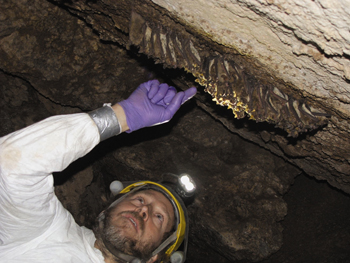Wildlife: White Nose Syndrome Update

Checking caves for White Nose Syndrome, Photo © Mylea Bayless, Bat Conservation International, www.batcon.org
This is Passport to Texas
North America’s bats are dying off at an alarming rate.
06—The current estimate is more than 5.7 million bats have been killed by white nose syndrome.
Texas Parks and Wildlife mammalogist, Jonah Evans, says it’s been spreading south and west.
12— The closest [to Texas] it’s been confirmed is in Mississippi. And it does continue to be found further and further west – closer to Texas. So, we’re very concerned that it could get here.
Researchers thought they’d discovered the fungus in an Oklahoma bat colony in 2010; additional testing proved the sample similar, yet unrelated and non-lethal.
05—That is a huge relief, because that was next door, and we were just terrified that it was coming.
White Nose Syndrome, which forms a fungal mat over the faces of hibernating bats, thrives in cooler climates. This makes Texas officials hopeful state bat colonies will remain unaffected; nevertheless, they will remain vigilant.
11—The place that we’ve identified as most likely to be susceptible to white nose syndrome is up in the Panhandle, where there’s a fair
number of hibernating bats, and it gets cold.
How the white nose fungus moves from one area to another, and what we can do to slow its progress. That’s tomorrow.
The Wildlife and Sport Fish Restoration program supports our series… and receives funds from your purchase of fishing and hunting equipment and motor boat fuel.
For Texas Parks and Wildlife, I’m Cecilia Nasti.


 Passport to Texas is a
Passport to Texas is a  Passport to Texas is made available by:
Passport to Texas is made available by: